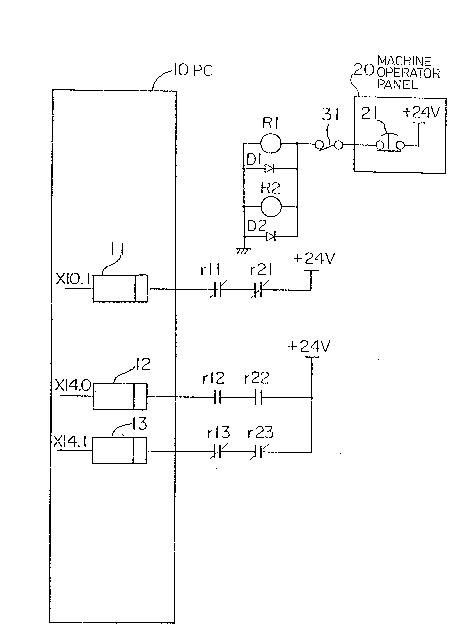Une partie des informations de ce site Web a été fournie par des sources externes. Le gouvernement du Canada n'assume aucune responsabilité concernant la précision, l'actualité ou la fiabilité des informations fournies par les sources externes. Les utilisateurs qui désirent employer cette information devraient consulter directement la source des informations. Le contenu fourni par les sources externes n'est pas assujetti aux exigences sur les langues officielles, la protection des renseignements personnels et l'accessibilité.
L'apparition de différences dans le texte et l'image des Revendications et de l'Abrégé dépend du moment auquel le document est publié. Les textes des Revendications et de l'Abrégé sont affichés :
| (12) Demande de brevet: | (11) CA 2039163 |
|---|---|
| (54) Titre français: | SYSTEME DE DETECTION DE FUSION POUR RELAIS |
| (54) Titre anglais: | FUSION DETECTING SYSTEM FOR RELAYS |
| Statut: | Réputée abandonnée et au-delà du délai pour le rétablissement - en attente de la réponse à l’avis de communication rejetée |
| (51) Classification internationale des brevets (CIB): |
|
|---|---|
| (72) Inventeurs : |
|
| (73) Titulaires : |
|
| (71) Demandeurs : |
|
| (74) Agent: | MARKS & CLERK |
| (74) Co-agent: | |
| (45) Délivré: | |
| (86) Date de dépôt PCT: | 1990-08-29 |
| (87) Mise à la disponibilité du public: | 1991-03-02 |
| Licence disponible: | S.O. |
| Cédé au domaine public: | S.O. |
| (25) Langue des documents déposés: | Anglais |
| Traité de coopération en matière de brevets (PCT): | Oui |
|---|---|
| (86) Numéro de la demande PCT: | PCT/JP1990/001095 |
| (87) Numéro de publication internationale PCT: | JP1990001095 |
| (85) Entrée nationale: | 1991-04-15 |
| (30) Données de priorité de la demande: | ||||||
|---|---|---|---|---|---|---|
|
ABSTRACT OF THE DISCLOSURE
A fusion detecting system for relays is provided for
detecting a fusion of relay contacts. Two fully-
interlocked or semi-interlocked relays are connected in
such a manner that they operate under identical conditions,
and a fused state is detected based on the states of
signals sent from series-connected make contacts and
series-connected break contacts of the two relays. In the
case of semi-interlocked relays (R1, R2), if a make contact
(r12) is fused during a current supply to a coil, the other
contact (r22) remains in an open state or at a make-contact
side after the current supply to the coil is cut off, and
if a break contact (r11) is fused, the other contact (r21)
remains in an open state or at break-contact side after a
current is supplied to the relay coil. Accordingly, by
using two semi-interlocked relays under identical
conditions and connecting same such that the make contacts
and the break contacts are individually connected in
series, a fusion of the relays can be detected based on
signals sent from the contacts. A fusion of fully-
interlocked relays can be detected in a like manner.
Note : Les revendications sont présentées dans la langue officielle dans laquelle elles ont été soumises.
Note : Les descriptions sont présentées dans la langue officielle dans laquelle elles ont été soumises.

2024-08-01 : Dans le cadre de la transition vers les Brevets de nouvelle génération (BNG), la base de données sur les brevets canadiens (BDBC) contient désormais un Historique d'événement plus détaillé, qui reproduit le Journal des événements de notre nouvelle solution interne.
Veuillez noter que les événements débutant par « Inactive : » se réfèrent à des événements qui ne sont plus utilisés dans notre nouvelle solution interne.
Pour une meilleure compréhension de l'état de la demande ou brevet qui figure sur cette page, la rubrique Mise en garde , et les descriptions de Brevet , Historique d'événement , Taxes périodiques et Historique des paiements devraient être consultées.
| Description | Date |
|---|---|
| Inactive : CIB désactivée | 2011-07-26 |
| Inactive : CIB de MCD | 2006-03-11 |
| Inactive : CIB de MCD | 2006-03-11 |
| Inactive : CIB dérivée en 1re pos. est < | 2006-03-11 |
| Demande non rétablie avant l'échéance | 1993-02-28 |
| Le délai pour l'annulation est expiré | 1993-02-28 |
| Inactive : Demande ad hoc documentée | 1992-08-31 |
| Réputée abandonnée - omission de répondre à un avis sur les taxes pour le maintien en état | 1992-08-31 |
| Demande publiée (accessible au public) | 1991-03-02 |
| Date d'abandonnement | Raison | Date de rétablissement |
|---|---|---|
| 1992-08-31 |
Les titulaires actuels et antérieures au dossier sont affichés en ordre alphabétique.
| Titulaires actuels au dossier |
|---|
| FANUC LTD |
| Titulaires antérieures au dossier |
|---|
| YOSHINORI HOSHINO |